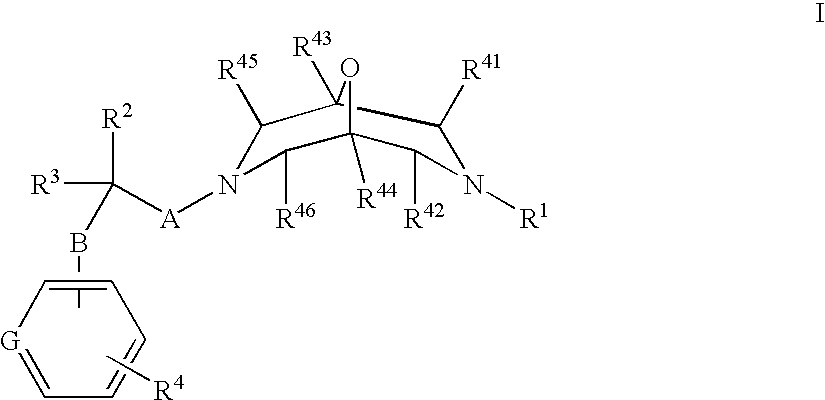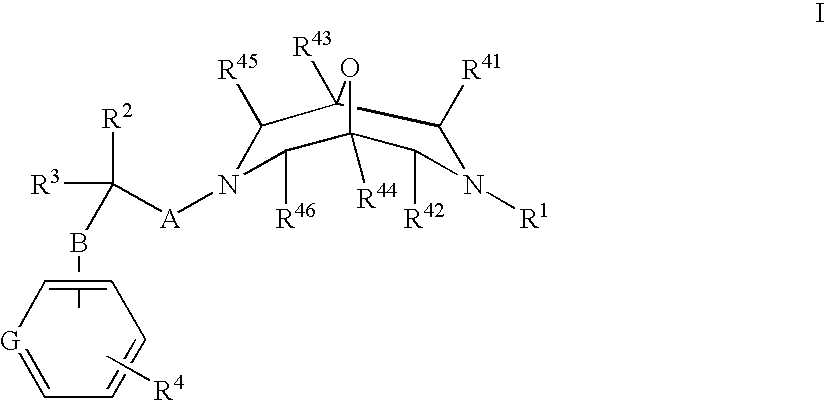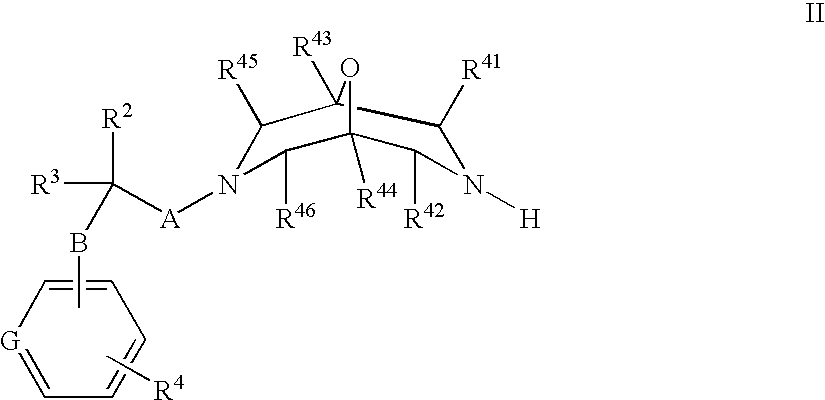New oxabispidine compounds useful in the treatment of cardiac arrhythmias
a technology of oxabispidine and compounds, applied in the field of new oxabispidine compounds useful in the treatment of cardiac arrhythmias, can solve problems such as (turning points)
- Summary
- Abstract
- Description
- Claims
- Application Information
AI Technical Summary
Benefits of technology
Problems solved by technology
Method used
Image
Examples
preparation b
4-{[(2S)-2-Hydroxy-3-(9-oxa-3,7-diazabicyclo[3.3.1]non-3-yl)propyl]-oxy}be-nzonitrile
(i) 4-[(2S)-Oxiranylmethoxy]benzonitrile
[0398] Potassium carbonate (414 g) and (R)-(-)-epichlorohydrin (800 mL) were added to a stirred solution of p-cyanophenol (238 g) in 2.0 L MeCN and the reaction mixture was refluxed under an inert atmosphere for 2 h. The hot solution was filtered and the filtrate concentrated, giving a clear oil which was crystallised from di-iso-propyl ether giving the product in 90% yield.
(ii) tert-Butyl 7-[(2S)-3-(4-cyanophenoxy)-2-hydroxypropyl]-9-oxa-3,7-diaz-abicyclo[3.3.1]nonane-3-carboxylate
[0399] A mixture of tert-butyl 9-oxa-3,7-diazabicyclo[3.3.1]nonane-3-carbo-xylate (prepared in an analogous fashion to the compound of Preparation A(vi) above; 0.72 g, 3.2 mmol) and 4-[(2S)-oxiranylmethoxy]benzonitrile (from step (i) above; 0.56 g, 3.2 mmol) in IPA / water (11 mL of 10:1) was stirred at 60.degree. C. for 18 h. The solvent was then evaporated to give 1.3 g (100%) of th...
preparation d
4-[2-(9-Oxa-3,7-diazabicyclo[3.3.1]non-3-yl)ethoxy]benzonitrile
(i) 4-(2-Bromoethoxy)benzonitrile
[0405] A mixture of 4-cyanophenol (35.7 g, 0.3 mol), K.sub.2CO.sub.3 (41.4 g, 0.3 mol) and 1,2-dibromoethane (561 g, 3.0 mol) in MeCN (450 mL) was stirred under reflux overnight. The mixture was filtered and evaporated to give 30.2 g (45%) of the sub-title compound, which was used without further purification.
(ii) tert-Butyl 7-[2-(4-cyanophenoxy)ethyl]-9-oxa-3,7-diazabicyclo[3.3.1]--nonane-3-carboxylate
[0406] The sub-title compound was prepared in 85% yield according to the procedure described in Preparation C(iii) above, using 4-(2-bromoethoxy)-benzonitrile (0.8 g, 3.5 mmol, 1.03 eq.) and triethylamine (1.5 eq.) in place of 3-(4-cyanoanilino)propyl 4-methylbenzenesulfonate, and K.sub.2CO.sub.3, respectively.
(iii) 4-[2-(9-Oxa-3,7-diazabicyclo[3.3.1]non-3-yl)ethoxy]benzonitrile
[0407] The title compound was obtained in 95% yield according to the procedure described in Preparation B(iii) abo...
example 1
4-{2-[7-(3,3-Dimethyl-2-oxobutyl)-9-oxa-3,7-diazabicyclo[3.3.1]non-3-yl]et-hyl}benzonitrile
(i) tert-Butyl 7-(3,3-dimethyl-2-oxobutyl)-9-oxa-3,7-diazabicyclo[3.3.1]-n-onane-3-carboxylate
[0513] A mixture of tert-butyl 9-oxa-3,7-diazabicyclo[3.3.1]nonane-3-carbo-xylate hydrochloride (Preparation A; 0.26 g, 1.0 mmol) and K.sub.2CO.sub.3 (1.45 g, 10.5 mmol) in MeCN (8 mL) was treated with 1-chloropinacolone (0.216 g, 1.6 mmol), and the mixture stirred at 40.degree. C. overnight. The following morning, the temperature was raised to 50.degree. C. for 4 h before the solids were filtered off from the mixture and the filtrate concentrated in vacuo. The crude product was dissolved in DCM and the solution was added to an ion-exchange solid phase extraction plug (10 g CBA (carboxylic acid on silica support)). After 1 h, the plug was washed with DCM (15 mL), after which the product was finally eluted with dichloromethane:MeOH:TEA (90:5:5). The solvents were evaporated to give 0.276 g (85.5%) of t...
PUM
| Property | Measurement | Unit |
|---|---|---|
| temperature | aaaaa | aaaaa |
| temperature | aaaaa | aaaaa |
| temperature | aaaaa | aaaaa |
Abstract
Description
Claims
Application Information
 Login to View More
Login to View More - R&D
- Intellectual Property
- Life Sciences
- Materials
- Tech Scout
- Unparalleled Data Quality
- Higher Quality Content
- 60% Fewer Hallucinations
Browse by: Latest US Patents, China's latest patents, Technical Efficacy Thesaurus, Application Domain, Technology Topic, Popular Technical Reports.
© 2025 PatSnap. All rights reserved.Legal|Privacy policy|Modern Slavery Act Transparency Statement|Sitemap|About US| Contact US: help@patsnap.com



